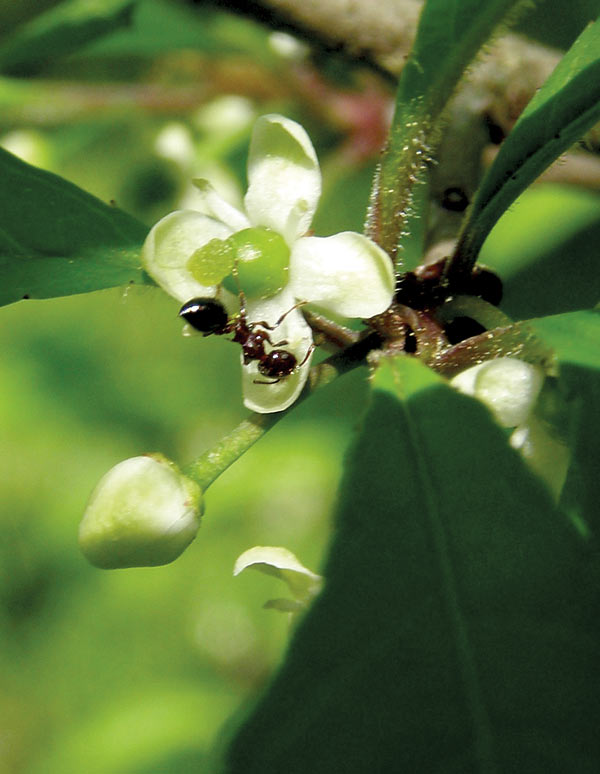Holly flowers

An ant exploring a female holly flower. Note the immature berry at the flower center. Photo by Ken Moore
By Ken Moore
Holly flowers are really neat. Though not big and showy like dogwoods and magnolias, once you have looked closely at a cluster of holly flowers you may get hooked on looking forward to them each spring. And you’ll feel really special when you can determine for your neighbors and friends whether or not a particular holly will have berries in the fall.
Knowing that holly trees are either male or female, you can describe that a winter berry display on a female tree depends upon the presence of a male holly within flying distance for insects to carry pollen from the male to the female tree.
I took a close look at the male and female Deciduous Hollies, Ilex decidua, in my yard. All holly flowers have four petals, though you may find a five-petal flower among all the others. There’s always an exception to the rule.
Female flowers are distinguished by having a little green bump, an immature ovary, in the center. That’s the future holly berry. The four accompanying stamens are nonfunctional, in that they do not produce pollen bearing anthers.
The flowers of the male tree are more numerous than the sparsely flowered female trees and the stamens are quite obvious, with globs of pollen waiting to adhere to the body of some unsuspecting insect for the flight over to those female flowers.
I noticed several ants crawling among the female flowers. I’m not certain what attracted them to make such a long journey up the tree and out to those flowers – perhaps to collect some nectar or nibble at the tips of the nonfunctional stamens. I don’t think the ants are the effective pollinators. I can’t imagine even a diligent ant, making the long journey from a male tree to a female tree, inadvertently making a pollen transfer. It will require a good bit of ant antics observation to know for certain.
The recent rains were not extensive enough to interrupt the flying-insect activity, so my deciduous hollies are loaded with tiny green berries. Sparse holly fruiting in some years results from extended cool, rainy periods that prevent the boy and girl trees from getting together. Now I have my fingers crossed that I won’t lose my anticipated holly-berry displays this year as I did last year due to the harsh drought.
The photos accompanying this article is of the Deciduous Holly. They have just about finished flowering. The similar flowers of evergreen American Holly, Ilex opaca, are just now fully opening, so you still have an opportunity to discover holly flowers.
So, while they are out there carrying on, take yourself outside to have a closer look at your holly flowers. If you notice passers-by giving you a curious look, invite them to share in your discovery. At least they will learn that you’re simply a normal human out enjoying nature.

Pollen evident on the male holly flowers. Note the uncharacteristic five-petal flower in the lower right. Photo by Ken Moore


Comments are closed.